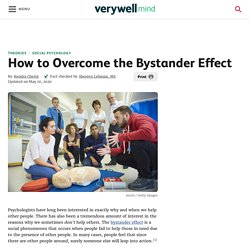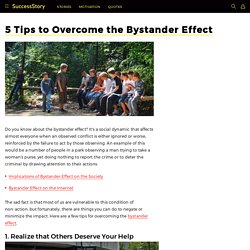

Scenario 1. Scenario 2. Why we still look away: Kitty Genovese, James Bulger and the bystander effect. More than half a century later, the death of Kitty Genovese continues to remind us of the disconnect between what we believe about ourselves and how we really act under pressure.

The murder of the 28-year-old outside her apartment in the Queens neighborhood of Kew Gardens in the early morning of 13 March 1964 rippled through New York City and around the world. How could a young, independent woman who lived on her own terms be so easily struck down? How could so many neighbors look on and turn away as she was stabbed repeatedly on the street and in her apartment building? What did that collective inability to act reveal about ourselves, our communities, and our belief systems? Genovese’s killer, Winston Moseley, died in prison this week, bringing the case and its implications back into the spotlight. Two weeks after her murder, Rosenthal assigned a story with the damning headline: “Thirty-Seven Who Saw Murder Didn’t Call Police.”
Bystander inaction, like 7-Eleven assault, more likely with more witnesses, experts say - Chicago Tribune. Remembering Ilan Halimi. The murder of four people in the Hyper Cacher kosher store in Paris in January 2015 served as a wake-up call to Europe and much of the world what French Jews had known for a long time: European antisemitism was back, and with a vengeance.

This attack, coming on the heels of the Charlie Hebdo atrocity, could no longer be ignored. The vicious hatred for Jews that had been bubbling just under the surface among Europe's Islamist extremists—not to mention the far-right and far-left political fringes—had boiled over. From the beginning of the 2000s, while the Second Intifada was raging, France saw a worrying and rapid rise in public expressions of prejudice and violence against Jews. Anti-Zionism became an excuse to openly express hatred against the Jewish community. Halimi was a 23-year-old French Jew who worked as a salesman in a Paris cell phone store. On January 21, 2006, a group calling itself the Gang of Barbarians kidnapped him. Bystander Effect: Explained. Bystander Effect: In action.
1) The diffusion of responsibilities. How Diffusion of Responsibility Affects Group Behavior. 2) Pluralistic Ignorance. The Bystander Effect and Altruism. Learning Objectives Explain the factors that influence human altruism, including reciprocal altruism and diffusion of responsibility.

Go to YouTube and search for episodes of “Primetime: What Would You Do?” You will find video segments in which apparently innocent individuals are victimized, while onlookers typically fail to intervene. The events are all staged, but they are very real to the bystanders on the scene. The entertainment offered is the nature of the bystanders’ responses, and viewers are outraged when bystanders fail to intervene. Figure 1. When Do People Help? Social psychologists began trying to answer this question following the unfortunate murder of Kitty Genovese in 1964 (Dovidio, Piliavin, Schroeder, & Penner, 2006; Penner, Dovidio, Piliavin, & Schroeder, 2005). More recently, in 2010, Hugo Alfredo Tale-Yax was stabbed when he apparently tried to intervene in an argument between a man and woman. 3) Personal Judgements. How to Overcome the Bystander Effect.
Psychologists have long been interested in exactly why and when we help other people.

There has also been a tremendous amount of interest in the reasons why we sometimes don't help others. The bystander effect is a social phenomenon that occurs when people fail to help those in need due to the presence of other people. In many cases, people feel that since there are other people around, surely someone else will leap into action.1 While the bystander effect can have a negative impact on prosocial behavior, altruism and heroism, researchers have identified a number of different factors that can help people overcome this tendency and increase the likelihood that they will engage in helping behaviors.2 Some of these include: Witnessing Helping Behavior Sometimes just seeing other people doing something kind or helpful makes us more willing to help others.
Imagine that you are walking into a large department store. Being Observant Being Skilled and Knowledgeable Guilt Feeling Good. 5 Effective Tips to Overcome the Bystander Effect. Do you know about the bystander effect?

It's a social dynamic that affects almost everyone when an observed conflict is either ignored or worse, reinforced by the failure to act by those observing. An example of this would be a number of people in a park observing a man trying to take a woman's purse, yet doing nothing to report the crime or to deter the criminal by drawing attention to their actions. The sad fact is that most of us are vulnerable to this condition of non-action; but fortunately, there are things you can do to negate or minimize the impact. Here are a few tips for overcoming the bystander effect. 1. People tend to take action more often when they feel that someone is more worthy of their attention.
The lesson to take from this is: when you are not taking any sort of action to be helpful, consider your reasons carefully. 2. That's right. 3. 4. Many times, people want to do something but they feign indifference in the belief that someone else will step in. 5.